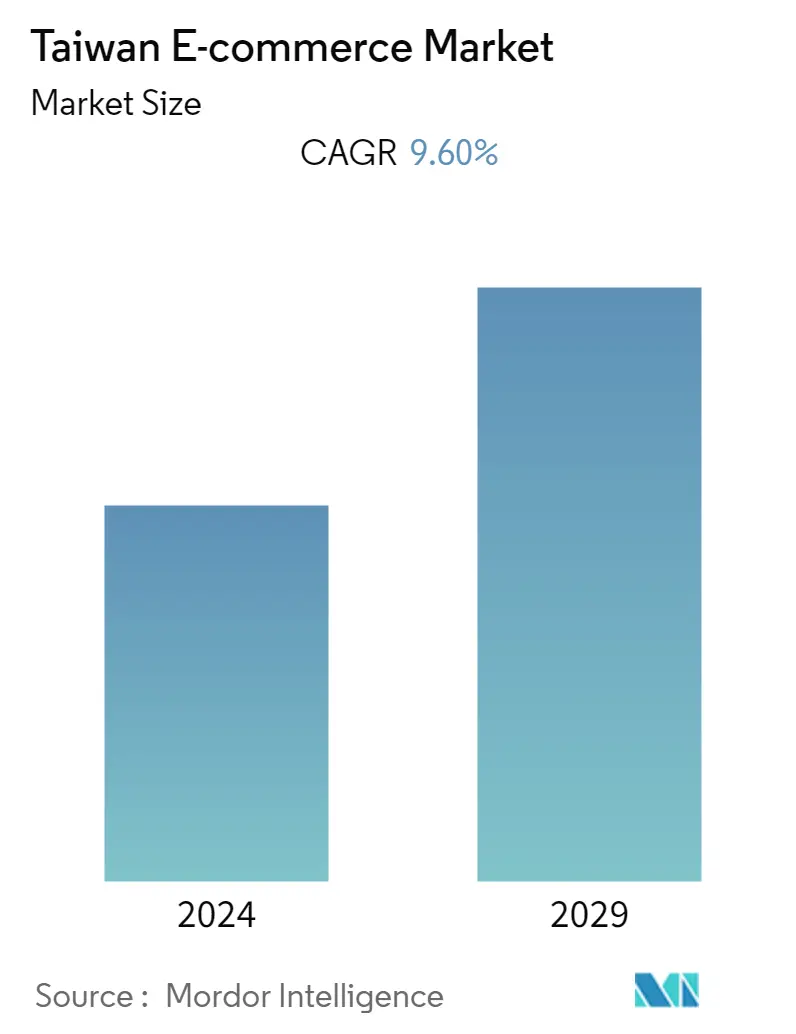Market Size of Taiwan E-commerce Industry

| Study Period | 2018 - 2028 |
| Base Year For Estimation | 2021 |
| Forecast Data Period | 2024 - 2028 |
| Historical Data Period | 2018 - 2020 |
| CAGR | 9.60 % |
| Market Concentration | Medium |
Major Players
*Disclaimer: Major Players sorted in no particular order |
Need a report that reflects how COVID-19 has impacted this market and its growth?
Taiwan E-commerce Market Analysis
The Taiwan E-commerce market is expected to register a CAGR of 9.6% during the period 2022-2027. The primary factor driving the growth of the market in the region is the high smartphone penetration and well-developed distribution services, among others.
- As Taiwan's E-commerce market continues to grow, an increasing number of younger shoppers choose to shop at online retailers. The focus on timely deliveries of household items, including the likes of groceries, has significantly driven their sales on the e-commerce channels. Furthermore, these online platforms have redefined and set new standards of consumer expectations creating new growth prospects for the vendors of the market.
- With advancements in supply chain systems and a change in consumer behavior, online shoppers are gaining more confidence in purchasing food and beverage products online, though challenges persist for perishable products. Furthermore, More brick-and-mortar retail vendors are investing heavily to integrate their online and offline resources to provide consumers with a more user-friendly shopping environment in the region.
- Online shoppers in the region have several payment options for their e-commerce purchases, such as mobile payment, credit card, cash, and Electronic stored value cards. Furthermore, mobile payment is the most preferred option for E-commerce purchases, followed by card payments. Mobile payment is gaining popularity as the smartphone penetration rate in the region is very high.
- The most significant factor impacting the growth of the E-commerce market is the perceived lack of security and privacy issues associated with online shopping. Taiwanese firms are particularly wary of this issue, probably more for cultural reasons and the underdeveloped legal framework protecting electronic shopping. These factors can hamper the growth of the E-commerce market in the region.
- During the COVID-19 pandemic, more physical consumption was forced to be transferred online, and more Physical retailers and brand owners are actively deploying online shopping channels, attracting more consumers to continue to shift, causing long-term changes in consumers' online shopping behavior and widely affecting their shopping frequency, items and amount in the region.
Taiwan E-commerce Industry Segmentation
E-commerce is the buying and selling goods and services over the internet through online shopping. However, e-commerce is often used to describe all the seller's efforts in selling products directly to consumers. It begins when potential customers learn about a product, buy it, use it, and ideally maintain lasting customer loyalty.
The study also tracks the key market parameters, underlying growth influencers, and major vendors operating in the industry, which supports the market estimations and growth rates over the forecast period in Taiwan. The study further analyzes the overall impact of COVID-19 on the ecosystem. The scope of the report encompasses market sizing and forecast for segmentation by B2B and B2C, in which the B2C channel is further segmented by application.
| By B2C E-commerce | ||||||||
| Market Size (GMV) for the Period of 2017-2027 | ||||||||
|
| By B2B E-commerce | |
| Market Size for the Period of 2017-2027 |
Taiwan E-commerce Market Size Summary
The Taiwan E-commerce market is predicted to grow at a steady rate in the coming years, driven by high smartphone penetration and well-developed distribution services. The market is seeing a surge in younger shoppers who prefer online retailers, especially for timely deliveries of household items. The online platforms have redefined consumer expectations, creating new growth opportunities for vendors. Moreover, advancements in supply chain systems and changing consumer behavior are boosting confidence in purchasing food and beverage products online. However, challenges persist for perishable products. A significant number of brick-and-mortar retail vendors are investing heavily to integrate their online and offline resources, providing a more user-friendly shopping environment. On the downside, the perceived lack of security and privacy issues associated with online shopping could hamper the growth of the E-commerce market in the region. Despite this, the COVID-19 pandemic has led to more physical consumption being transferred online, causing long-term changes in consumers' online shopping behavior. The growing number of online shoppers, coupled with well-developed telecom infrastructure and a well-developed logistics network, is attracting more people to buy and sell through online channels. Social media, particularly Facebook, has become an essential tool for marketing products sold online in Taiwan. The rising popularity of smartphones and tablets is leading to an increase in the number of people who use wireless internet, including mobile internet. This is resulting in a rise in the number of mobile commerce services and applications used by customers in Taiwan.
Explore MoreTaiwan E-commerce Market Size - Table of Contents
-
1. MARKET INSIGHTS
-
1.1 Market Overview
-
1.2 Industry Attractiveness - Porter's Five Forces Analysis
-
1.2.1 Bargaining Power of Suppliers
-
1.2.2 Bargaining Power of Buyers/Consumers
-
1.2.3 Threat of New Entrants
-
1.2.4 Threat of Substitute Products
-
1.2.5 Intensity of Competitive Rivalry
-
-
1.3 Key Market Trends and Share of E-commerce of Total Retail Sector
-
1.4 Impact of COVID-19 on the E-commerce Sales
-
-
2. MARKET SEGMENTATION
-
2.1 By B2C E-commerce
-
2.1.1 Market Size (GMV) for the Period of 2017-2027
-
2.1.2 Market Segmentation - by Application
-
2.1.2.1 Beauty and Personal Care
-
2.1.2.2 Consumer Electronics
-
2.1.2.3 Fashion and Apparel
-
2.1.2.4 Food and Beverages
-
2.1.2.5 Furniture and Home
-
2.1.2.6 Others (Toys, DIY, Media, etc.)
-
-
-
2.2 By B2B E-commerce
-
2.2.1 Market Size for the Period of 2017-2027
-
-
Taiwan E-commerce Market Size FAQs
What is the current Taiwan E-commerce Market size?
The Taiwan E-commerce Market is projected to register a CAGR of 9.6% during the forecast period (2023-2028).
Who are the key players in Taiwan E-commerce Market?
Shopee Pte. Ltd., PChome Online, Ruten, Momo Com Inc and BigGo are the major companies operating in the Taiwan E-commerce Market.
